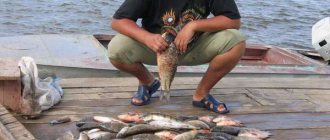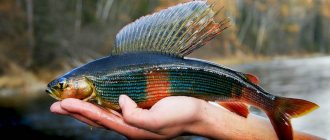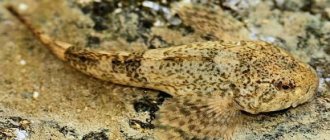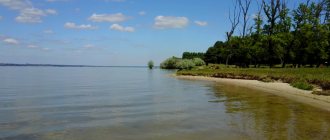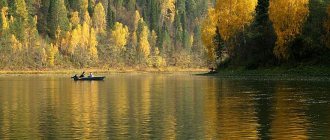Gorchak fish lives in freshwater standing or weak-current reservoirs. These small and beautiful fish have a rather exotic type of relationship with bivalves.
And their mutual influence on the diversity of the ichthyofauna of our rivers and lakes is, without exaggeration, enormous. In shape and description, the bitter fish is similar to a small multi-colored crucian carp, as can be seen from the photo below in the text.
Description and photo of bitterling
The bitterlings have a tall and short body, up to 9 cm, with large scales. Usually its length “floats” in the range from 4 to 8 cm. The sides are compressed, the head is small relative to the body, with yellow eyes and orange specks above the pupils. The mouth is semi-inferior, oblique. The pharyngeal teeth are single-rowed. The lateral line is visible only on the first 4-7 scales; in total, the fish has from 34 to 40 transverse rows.
Common mustard (from the Latin Rhodeus sericeus) belongs to the genus of ray-finned fish and the carp family (Cyprinidae).
The most common names for mustard among people are bitter, sinyavka, mustard, mustard, pukasik, etc.
The name of the fish probably comes from the bitter taste of its meat. This bitterness appeared due to the characteristics of the diet. After all, bitterlings feed mainly on bitter algae - diatoms and filamentous algae.
Another species of bitterling is common in Europe - European bitterling (Rhodeus amarus).
European bitterweed (Rhodeus amarus)
Externally, in terms of description and habits, the fish practically do not differ from each other. also belongs to the carp family.
Distributed in European countries in the river basins of France, up to the Neva in the Russian Federation.
Behavior and Compatibility
Peaceful, calm fish. Considering the peculiarities of keeping Gorchak, compatible species include only those that can live in unheated aquariums, for example, Goldfish.
Brief information:
- The volume of the aquarium is from 80–100 liters.
- Temperature - 18–22°C
- pH value – 7.0–7.4
- Water hardness - medium and high hardness (8–20 dGH)
- Substrate type - sand
- Lighting - dim
- Brackish water - no
- Water movement - moderate to weak
- The size of the fish is about 9 cm.
- Nutrition - any with a high content of herbal supplements
- Temperament - peaceful
- Living alone, in pairs or in a group
Spawning bitterling and shellfish
Upon reaching 2-3 years of age, bitterlings can reproduce. At this time, the size of the fish is only 3-4 cm. Males develop nuptial coloration during the spawning period. L.P. Sabaneev described the male bitterling as follows:
“His back and sides become dark purple, the side stripe becomes bright green and reaches almost to the middle of the body; the chest and belly get a pinkish tint; the fins are also made more variegated and bright (reddish in various shades with a black edge). In addition, small white warts are noticeable on both sides of the eyes and mouth.”
The females remain inconspicuous, but they grow a long ovipositor, up to 4-5 cm long.
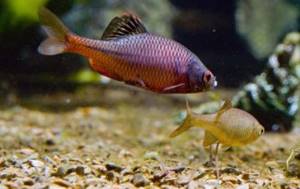
A male bitterling fish in breeding plumage and a female with an ovipositor
The process of reproduction and the type of relationship between the bitterling fish and the bivalve mollusk pearl barley (Unio) and toothless mollusk (Anodonta) are interesting.
The male selects a group of mollusks and protects them from other males. The female, using the ovipositor, lays eggs inside the slightly open shell.
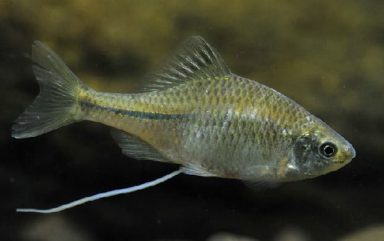
Female bitterling during spawning period
An alarmed mollusk, sensing foreign bodies inside, slams the valves and begins to intensively pump water through itself, trying to remove them. At this time, the male releases milk, which, with a current of water, enters the shell, where fertilization of the eggs occurs.
Thus, 4-5 eggs are “settled” into the shell at a time, where they turn into fry. The bitterling spawns in portions; in total, the female lays up to 280 eggs. Leaving the shell, the fry “carry away” the larvae of mollusks, helping the species spread throughout the reservoir.
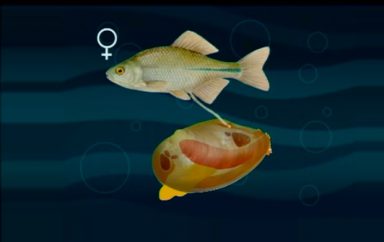
Interspecific relationships between bitterling and mollusk during spawning
So, we observe interspecific relationships in the survival of fish and river shells. The bitterlings help the toothless and pearled beetles to develop new territories, and the latter provide a place for reproduction, protection and food for the offspring of the bitterlings.
Maintenance and care, arrangement of the aquarium
They are considered an unpretentious and hardy species. They live equally successfully in both open ponds and home aquariums. Successful maintenance depends on maintaining a stable hydrochemical composition of water at relatively low temperatures. The main threat is overheating; fish should not be allowed to remain above 22°C for a long time. For this reason, there is no need for a heater.
In the design, it is desirable to provide places for shelters with dense aquatic vegetation, for example, thickets of Vallisneria, pondweed, elodea, and water lilies. Additionally, you can place driftwood and piles of stones. Any soil. However, if breeding is planned, then it is necessary to place a soft substrate suitable for the life of bivalves.
Maintenance is standard and no different from caring for a tropical freshwater aquarium. It is recommended to regularly remove accumulated waste, weekly update of some of the water with fresh water and maintenance of equipment, primarily the filtration system.
Nutrition
In nature, the basis of the diet is algae and aquatic plants. In the home aquarium, they can be accustomed to popular dry foods in the form of flakes and granules, provided they contain a large amount of plant components.
Habits of bitterling
Gorchakov are not so easy to notice in the water, unlike bleak. The fish live in schools in places where barley and toothless fish accumulate and not far from algae thickets. Moreover, in a flock of bitterlings there are about 5-6 times more females than males.
The life of a fisherman passes unnoticed and it does not show itself in any way on the pond. The fish preferentially stay on sandy-pebbly, sandy-stone bottoms. In rivers these are coastal channels and creeks; in lakes these are quiet, shallow places.
Mustards do not migrate; the place they choose once remains constant throughout their life.
Breeding/reproduction
Gorchaki have a unique breeding strategy. During evolution, in order to protect their offspring, fish learned to lay eggs in the cavity of bivalves. With the onset of the mating season, which in nature begins at the end of winter, beginning of spring, the females grow the above-mentioned ovipositor, which resembles a long tube. Using a tube, the female places a portion of eggs between the open valves of the mollusk, and the male simultaneously sprays a cloud of milk. Up to 5 eggs can be placed at a time. Spawning can last several weeks.
The incubation period occurs inside the shell. The mollusk does not experience any negative effects from this. On the contrary, the emerging fry carry its larvae on themselves, thereby contributing to the increase in habitats.
Catching bitterling
How and what to fish for bitterling fish? There is no need to prepare specially for fishing and go after a bruise. This fish is often caught in the bycatch of roach, rudd, and bleak. If you only set your mind on bitterling, the maximum that you can catch is 4-5 individuals.
Gorchak is not a poisonous fish! It has no commercial significance; it is useless in cooking, as it is small and bitter, unless you are a culinary gourmet.
Gorchak is caught with a regular float rod, mainly with black bread. An ordinary light tackle with a small hook, for example, the same as for bleak, will do. The bites of the bluefish are indecisive; often he simply sucks on the bait.
Video about bitterling fish, description and catching
Some use caught bitterlings as bait for perch and pike, but opinions vary. Some say that bitterling is exceptionally good as a live bait, others say it is useless, since the predator disdains it.
Description of fish and habitat
Freshwater bitterling looks like a miniature crucian carp , growing from 5 to 12 centimeters. Weighs up to 20 grams. Life expectancy is, on average, 5−6 years. The body is tall, covered with silvery, large scales, the abdomen is white, the eyes are yellowish, with an orange spot in the upper part. The dorsal fin is elongated, the head is medium, the mouth is small. A distinctive feature of the species is a pale green stripe in the tail.
The color of the fish changes depending on the time of year. During the mating season, the male becomes an elegant purple color with bright reddish fins, the lateral stripe lengthens and becomes bright green. Small wart-like growths appear around the mouth and eyes. The female does not particularly stand out; her color is pink-pearl.
Gorchak fish is found in eastern Russia, in the Volga region and Sakhalin. In Europe, it lives in Germany and France, as well as in the basins of the Black and Caspian Seas. The Amur species is common in China, South Korea, Mongolia and Vietnam. Gorchak is found in Belarusian Polesie and the southwestern regions of Ukraine. With a large population of fish, it is not of commercial interest.
Different types of bitterweed have their own habitat . The fish likes bodies of water with stagnant water or weak currents, so it can be found in small lakes, ponds, and swamps. She prefers to live in backwaters and shallow bays. These are mainly habitats for mollusks, which is due to the breeding habits of the fish.
The fish prefer to live in a school of up to 60 or more individuals. There are always more females in a group. They are very cautious and timid, feeding only on algae, which also protects them from enemies. When attacked by a predator, they develop very high speed, while managing to deftly dodge its sharp teeth.
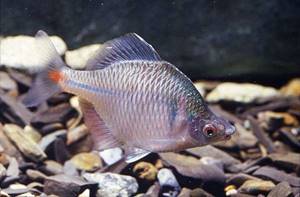
In nature, there are about 20 species of bitterling. The most common of them:
- ordinary,
- Amur,
- ocellated,
- barbed,
- bitter light.
Characteristics of species
There are about 20 subspecies in total. They have their own distinctive features and localization. The most common types of bittersweet are:
- Leytha;
- Amursky;
- Ocellated;
- Barbed.
Leita can be found in water bodies of China and the Russian Far East. Sometimes such fish can be found in the tributaries of the Amur and in the Primorsky Territory. It grows up to 5-6 cm in length. Its distinctive feature is its bright color : the back is green, there are blue and pink spots in the area of the gill wings, and there is an ultramarine stripe on the tail. This subspecies feeds on mosquitoes, plankton and small algae.
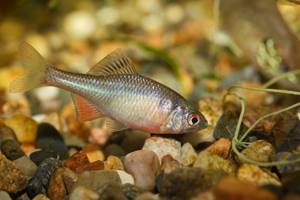
Leita - one of the varieties of bittersweet
Amur bitterling is localized in China, Sakhalin, Mongolia, in the basin of the Sea of Okhotsk and the Sea of Japan. Most often, such fish live in completely stagnant or low-flowing water. The diet mainly consists of filamentous algae. Outwardly, it is very similar to an ordinary bruise, but has a darker color.
The ocellated bitterling lives in the lakes of Central Asia. A distinctive feature is the eye spot on the dorsal fin.
Prickly bitterling is quite large in size. On average, such fish can reach 15-16 cm in length. It feeds on plant foods and larvae of chironomids and small crustaceans. This variety can be found in Korea, Mongolia and northeastern China.
Features of spawning
The bluebird is distinguished by an unusual spawning process. The peculiarity is that the fish uses a “natural incubator” - a living mollusk, which belongs to the Unionidae family. Spawning occurs in several stages, which last from May to August. During the mating season, males acquire a purple-red color and begin to fight among themselves for the attention of females. At the same time, they “pick up” bivalves in which the larva will develop.
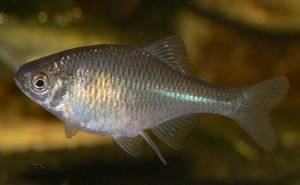
They use a live mollusk to lay their eggs.
Females have a transparent organ in the form of an oviduct. It can reach 4 to 5 cm in length. This oviduct is densely filled with yellow eggs. There are about 200−250 of them in total. During spawning with a tubular organ, eggs are laid in shells. One can fit from 5 to 30 pieces. The male places milt in the same shell. Sometimes it happens that one shell can contain from 10 to 15 clutches.
Larvae begin to appear after 3-4 days. The basis of the fry’s diet is plankton, and after 17-20 days the diet already includes plant food.
Keeping in an aquarium
All types of bitterlings are suitable for breeding in a home tank. The fish is unpretentious, has a strong immune system, is friendly and feels great at a constant water temperature of +18-22°C. Among other microclimatic indicators of the environment, hardness (dH 12-150, maximum up to 200) and acidity (pH = 6.8-7.5) are important. Good filtration and aeration, weekly addition of settled water (1/4 of the container), and bottom cleaning of excess organic waste are also necessary.
Under natural conditions, bitterling lives on a sandy bottom, so the aquarium needs fine rocky soil with a layer of 5-7 cm. It is also desirable to have natural plants with a developed root system, since most cyprinids can easily dig them up.
To learn more:
Taimen: a valuable fish of the salmon family
Under artificial conditions, the fish willingly eats animal plant food, flakes, granules, and bread. The optimal settlement option is a flock of 5-7 individuals, preferably with a quantitative predominance of females.
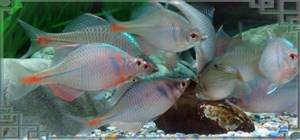
Gorchak in nature
Rhodeus sericeus (that's the Latin name for the fish) is very common. It can be found in Central and Eastern Europe, Asia Minor, Transcaucasia, and the European part of Russia. Moreover, in different regions these cyprinids are called differently: alder, bitterling, little one, garva, bitterling, sinyavka, patsyuk, pukas, pukasik, garkusha, etc.
The favorite places of common bitterweed are coastal zones of water bodies (rivers, lakes, less often ponds) with a very slow current or without it at all. Their banks are densely covered with vegetation, and the bottom is sandy.
Interesting fact! In those areas where the bottom is covered with silt or mud, you will not find bitterling. Scientists attribute this to the fact that bivalves, which are closely related to the reproduction process of these fish, do not live there.


